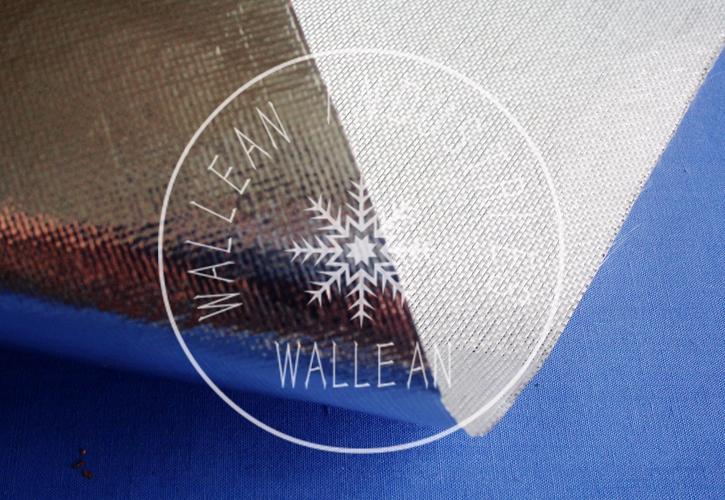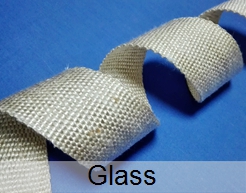
Alum foil laminated glass cloth
Description
- One side coated with Aluminum foil/polyester film. Protection from intense radiant heat.
- Reflects more than 95% of the radiant heat that contacts its surface
- Excellent radiant heat protection from sources such as super-hot metal slabs, proximity to liquid metal, infrared heaters, open flame / plasma or engine exhaust manifolds is a concern.
Constructed from a high temperature base filament/texturized fiberglass fabric which is then coated with highly reflective polished aluminum. The aluminum foil coating melts at 1220¡ãF / 660¡ãC, however it does take some time for the aluminum foil to absorb enough heat to melt, thereby it can withstand short exposure to the higher temperatures. The basic fiberglass fabric is 1000¡ãF/537¡ãC, while adhesive will burn-off or vaporize at temperatures above 300¡ãF/148¡ãC.
Specification
|
300¡ãF / 148¡ãC: Aluminium Foil/Polyester film Laminated Fiberglass Fabric |
|||||
|
Part Number |
Thickness (mm) |
Width (mm) |
Length (m/roll) |
Weave |
Base fabric weight (g/©O) |
|
WFF102A |
0.2 |
1000 |
50 |
Plain |
200 |
|
WFF1041A* |
0.4 |
1000 |
50 |
Twill |
430 |
|
WFF106A |
0.6 |
1000 |
50 |
D-Plain |
600 |
|
WFF1062A |
0.6 |
1000 |
50 |
Satin |
660 |
|
WFF108A |
0.8 |
1000 |
50 |
Stain |
840 |
|
WFF208A** |
0.8 |
1000 |
50 |
Plain |
650 |
|
WFF210A |
1.0 |
1000 |
50 |
Plain |
800 |
|
WFF215A |
1.5 |
1000 |
50 |
Plain |
1000 |
|
WFF220A |
2.0 |
1000 |
50 |
Plain |
1250 |
|
WFF230A |
3.0 |
1000 |
50 |
Plain |
1800 |
Aluminium foil thickness normally in 7,18, 20, 25 micron.
WFF1041A* is available of the other side with grey silicone coating;
WFF208A** is available with heat treatment.
Choose Aluminium foil or Mylay-Aluminium£¿ Choose Water base adhesive or Acrylic adhesive ?
Differences between Aluminium foil & Mylar- Aluminium:
Aluminum foil laminated fiberglass fabric can withstand higher temperature exposure than Mylar-aluminum coated fiberglass, but the aluminum foil is subject to mechanical and abrasion breakdown with handling, flexing and vibration. It is well suited for applications such as curtains, equipment covers and exhaust system blankets. The aluminum is calendared onto the fiberglass base fabric along with an adhesive. Aluminum foil coated fiberglass can be used to temperatures up to 1000¡ãF / 537¡ãC, however the adhesive will smoke-off above 300¡ãF/148¡ãC.
Mylar is a trade name for polyester. On Fiberglass coated with Mylar-aluminum, the Mylar-aluminium coating will melt and vaporize at a lower temperature than aluminum foil, but it performs better for applications such as bellows, flexible hose and cable covers, moving aperture shields, festoon covers, etc. where there is repetitive movement or flexing or abrasion. Mylar-aluminum coated fiberglass is typically suited to temperatures up to 440¡ãF / 226¡ãC, thereby no flame contact.
Water base adhesive or Acrylic adhesive used back aluminium:
Water base adhesive provide better flexibility and performance in higher temperature, but less stickiness, while Acrylic adhesive provide better stickiness and stiffer, especially for texturized fiberglass fabrics which is bulk with uneven surface, Acrylic adhesive is a better choice.
The most popular usage is Filament fiberglass fabric with water base adhesive laminated with Al foil or Mylar-aluminium, while Texturized fiberglass fabric with acrylic adhesive laminated with Al foil.
Choices can be :
Aluminium foil + Water base adhesive+ Filament fiberglass fabric
Aluminium foil + Acrylic adhesive + Filament fiberglass fabric
Aluminium foil + Water base adhesive+ Texturized fiberglass fabric
Aluminium foil + Acrylic adhesive + Texturized fiberglass fabric
Mylar-aluminium + Water base adhesive+ Filament fiberglass fabric
Mylar-aluminium + Acrylic adhesive + Filament fiberglass fabric
Mylar-aluminium + Water base adhesive+ Texturized fiberglass fabric
Mylar-aluminium + Acrylic adhesive + Texturized fiberglass fabric
Acrylic adhesive + Alumiunium foil is best choice, but more expensive.
PSA(pressure sensitive adhesive) Available
This fabric is also available with a self-adhesive backing. The adhesive is water adhesive based, and will burn-off or vaporize at temperatures above 300¡ãF/148¡ãC. If prolonged use of the self-adhesive fabric above 300¡ãF/148¡ãC is desired, then alternate securing methods such as fasteners, wire or clamps should be used. Personnel should avoid inhaling fumes from the PSA.
We have a SuperTemp adhesive can work at temperature 250degree C continuously.


